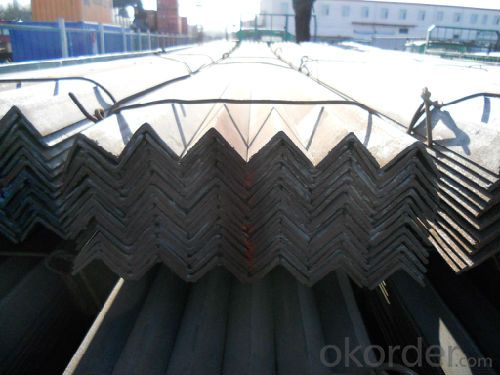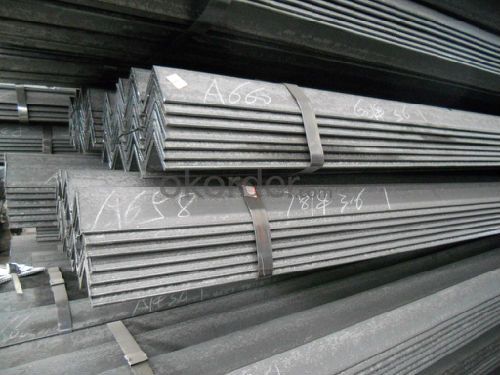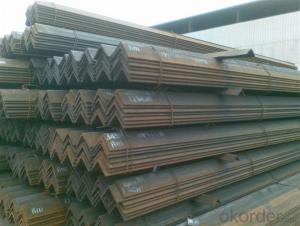Q345 Material High Quality Angle Steel
- Loading Port:
- Tianjin
- Payment Terms:
- TT or LC
- Min Order Qty:
- 25 m.t.
- Supply Capability:
- 2000 m.t./month
OKorder Service Pledge
OKorder Financial Service
You Might Also Like
Product Description:
OKorder is offering Angle Steel great prices with worldwide shipping. Our supplier is a world-class manufacturer of steel, with our products utilized the world over. OKorder annually supplies products to European, North American and Asian markets. We provide quotations within 24 hours of receiving an inquiry and guarantee competitive prices.
Product Applications:
According to the needs of different structures, Angle can compose to different force support component, and also can be the connections between components. It is widely used in various building structures and engineering structures such as roof beams, bridges, transmission towers, hoisting machinery and transport machinery, ships, industrial furnaces, reaction tower, container frame and warehouse etc.
Product Advantages:
OKorder's Angle Steelare durable, strong, and resist corrosion.
Main Product Features:
· Premium quality
· Prompt delivery & seaworthy packing (30 days after receiving deposit)
· Corrosion resistance
· Can be recycled and reused
· Mill test certification
· Professional Service
· Competitive pricing
Product Specifications:
1. Invoicing on theoretical weight or actual weight as customer request
2. Length: 6m, 9m, 12m as following table
3. Sizes
Sizes: 25mm-250mm | ||
a*t | ||
25*2.5-4.0 | 70*6.0-9.0 | 130*9.0-15 |
30*2.5-6.6 | 75*6.0-9.0 | 140*10-14 |
36*3.0-5.0 | 80*5.0-10 | 150*10-20 |
38*2.3-6.0 | 90*7.0-10 | 160*10-16 |
40*3.0-5.0 | 100*6.0-12 | 175*12-15 |
45*4.0-6.0 | 110*8.0-10 | 180*12-18 |
50*4.0-6.0 | 120*6.0-15 | 200*14-25 |
60*4.0-8.0 | 125*8.0-14 | 250*25 |
Note:
1. According to national standard (GB) for our products, if not, supply according to national standards (GB) or agreement.
2. We can not only provide electric furnace +LF+VD and electro-slag re-melting (ESR)steel forging materials, but also forging products of piece, bar, etc.
3. Our company is equipped with roll equipment and can provide our customers with roll billets or finished.
4. Please send us your detailed specifications when inquire. We will reply to you ASAP.
FAQ:
Q1: Why buy Materials & Equipment from OKorder.com?
A1: All products offered byOKorder.com are carefully selected from China's most reliable manufacturing enterprises. Through its ISO certifications, OKorder.com adheres to the highest standards and a commitment to supply chain safety and customer satisfaction.
Q2 What makes stainless steel stainless?
A2 Stainless steel must contain at least 10.5 % chromium. It is this element that reacts with the oxygen in the air to form a complex chrome-oxide surface layer that is invisible but strong enough to prevent further oxygen from "staining" (rusting) the surface. Higher levels of chromium and the addition of other alloying elements such as nickel and molybdenum enhance this surface layer and improve the corrosion resistance of the stainless material.
Q3 Can stainless steel rust?
A3 Stainless does not "rust" as you think of regular steel rusting with a red oxide on the surface that flakes off. If you see red rust it is probably due to some iron particles that have contaminated the surface of the stainless steel and it is these iron particles that are rusting. Look at the source of the rusting and see if you can remove it from the surface.
Images:


- Q:Can steel angles be used for architectural purposes?
- Certainly, steel angles can be utilized for architectural purposes. These versatile structural components find application in a myriad of architectural scenarios. Their primary function often involves providing crucial support and stability during building construction. For example, steel angles are employed as lintels or beams, effectively bearing the weight of walls, roofs, or floors. Furthermore, they serve as columns or braces, bolstering the overall structural integrity of a building. Moreover, steel angles can serve as decorative elements within architectural designs, imparting a contemporary and industrial aesthetic to the structure as a whole. Architects and engineers frequently opt for steel angles due to their robustness, resilience, and malleability when designing and erecting buildings.
- Q:How do steel angles contribute to the sustainability of a city?
- Steel angles contribute to the sustainability of a city in several ways. Firstly, steel angles are a crucial component in the construction industry, used in the fabrication of buildings, bridges, and other infrastructure. Steel is known for its strength, durability, and resistance to external factors such as corrosion and fire. By using steel angles in construction projects, cities can ensure the longevity and safety of their structures, reducing the need for frequent maintenance or replacement. This leads to a significant reduction in the consumption of resources over time, making cities more sustainable. Additionally, steel angles offer design flexibility, allowing architects and engineers to create innovative and efficient structures. Their versatility enables the construction of sustainable buildings that incorporate features such as energy-efficient designs, natural lighting, and effective insulation. By utilizing steel angles in the construction process, cities can promote sustainable practices and reduce energy consumption, contributing to a more sustainable urban environment. Furthermore, steel is a highly recyclable material, with a recycling rate of around 90%. By using steel angles in construction, cities can contribute to a circular economy by promoting the recycling and reuse of steel products. This reduces the demand for raw materials and minimizes waste, thereby reducing the environmental impact of construction projects. The use of recycled steel also helps to conserve energy and reduce greenhouse gas emissions associated with the production of new steel. In conclusion, steel angles play a vital role in the sustainability of a city by providing durable and long-lasting structures, enabling energy-efficient designs, and promoting the recycling and reuse of materials. By incorporating steel angles in construction projects, cities can create sustainable infrastructure that contributes to the overall well-being of the environment and the community.
- Q:What are the different surface coating options for steel angles?
- Some different surface coating options for steel angles include galvanization, powder coating, and painting.
- Q:What are the considerations for selecting the appropriate steel angle connection type?
- When selecting the appropriate steel angle connection type, several considerations need to be taken into account. These include the load requirements, the structural design, the available space, the cost, and the ease of installation. The load requirements determine the strength and stability needed for the connection, while the structural design dictates the type of connection that will best support the overall structure. The available space influences the size and configuration of the connection, ensuring it fits within the designated area. Cost is an important factor, as different connection types vary in terms of material and labor expenses. Lastly, the ease of installation determines the feasibility and efficiency of implementing the chosen connection type.
- Q:What is the fire resistance rating of steel angles?
- The fire resistance of steel angles relies on several factors, including the angle's size and thickness, the type of steel employed, and the specific fire protection measures implemented. Steel possesses inherent fire resistance due to its high melting point and low thermal conductivity. Nevertheless, the fire resistance can be improved by applying fireproofing materials, such as intumescent coatings or fire-resistant boards, to the steel angles. By providing insulation and slowing down heat transfer to the steel, these fire protection measures can significantly augment the fire resistance of steel angles. The specific fire resistance rating may differ depending on the thickness and type of fireproofing materials employed. For instance, a steel angle coated with a particular fireproofing substance may have a fire resistance rating of 60 minutes, signifying its ability to withstand fire exposure for up to 60 minutes without compromising its structural integrity. To determine the specific fire resistance requirements for steel angles in a specific application, it is crucial to refer to local building codes, regulations, and fire safety standards. These standards can offer guidance on the necessary fire protection measures and the minimum fire resistance ratings that must be met in different construction scenarios.
- Q:Can steel angles be used for reinforcement bars?
- No, steel angles cannot be used as reinforcement bars. Reinforcement bars are typically made of plain or deformed steel bars that are designed specifically for providing strength and stability to concrete structures. Steel angles, on the other hand, are primarily used for structural support or framing purposes and are not suitable for use as reinforcement bars.
- Q:Are steel angles suitable for mezzanine floors?
- Indeed, steel angles prove to be a fitting choice for constructing mezzanine floors. Their robustness, longevity, and affordability render them a prevalent choice in mezzanine floor construction. By delivering structural reinforcement and steadiness, steel angles facilitate the expansion of floor area. Their fabrication and installation are straightforward, thus contributing to their widespread adoption in the creation of mezzanine floors. Not only can they endure substantial loads, but they also provide a solid foundation for diverse applications, such as storage, offices, or supplementary workspaces. Furthermore, steel angles can be tailored to meet specific design prerequisites, showcasing their versatility as a prime option for mezzanine floor construction.
- Q:How do you calculate the moment capacity of a steel angle?
- To calculate the moment capacity of a steel angle, several factors need to be considered. Firstly, the geometry of the angle needs to be determined, including the dimensions of the flanges and the web. The width of the flanges (b) and the thickness of the flanges (tf) and the web (tw) are crucial parameters. Next, the yield strength of the steel material needs to be known. This value represents the stress level at which the steel begins to permanently deform. It can be obtained from the material specifications or testing. The moment capacity of a steel angle can then be calculated using the following equation: Mn = Z × Fy Where: Mn is the moment capacity of the angle (in lb-ft or N-m) Z is the plastic section modulus of the angle (in^3 or mm^3) Fy is the yield strength of the steel material (in psi or MPa) The plastic section modulus (Z) is a measure of the shape's resistance to bending. It can be found in reference tables or calculated using equations specific to the angle's geometry. Once the values for Z and Fy have been determined, they can be plugged into the equation to calculate the moment capacity (Mn) of the steel angle. It is important to note that this calculation assumes elastic behavior of the steel angle and does not account for factors such as strain hardening or local buckling. Additionally, it is crucial to check the calculated moment capacity against the design requirements and safety factors to ensure the angle is suitable for the intended application.
- Q:Can steel angles be used for manufacturing equipment frames?
- Indeed, the utilization of steel angles in the fabrication of equipment frames is possible. Their strength, durability, and versatility render steel angles frequently employed in construction and manufacturing fields. By providing structural support and stability, they prove to be an optimal choice for the design and construction of equipment frames. The ease with which steel angles can be welded or bolted together enables the creation of rigid and robust frame structures. Moreover, their ability to be cut into specific lengths and shapes allows for precise assembly and customization. In conclusion, the reliability and cost-effectiveness of steel angles make them a favored selection for the manufacturing of equipment frames.
- Q:What are the different methods of impact testing for steel angles?
- There are several methods of impact testing for steel angles, including the Charpy V-notch test, the Izod test, and the drop weight test.
1. Manufacturer Overview |
|
|---|---|
| Location | |
| Year Established | |
| Annual Output Value | |
| Main Markets | |
| Company Certifications | |
2. Manufacturer Certificates |
|
|---|---|
| a) Certification Name | |
| Range | |
| Reference | |
| Validity Period | |
3. Manufacturer Capability |
|
|---|---|
| a)Trade Capacity | |
| Nearest Port | |
| Export Percentage | |
| No.of Employees in Trade Department | |
| Language Spoken: | |
| b)Factory Information | |
| Factory Size: | |
| No. of Production Lines | |
| Contract Manufacturing | |
| Product Price Range | |
Send your message to us
Q345 Material High Quality Angle Steel
- Loading Port:
- Tianjin
- Payment Terms:
- TT or LC
- Min Order Qty:
- 25 m.t.
- Supply Capability:
- 2000 m.t./month
OKorder Service Pledge
OKorder Financial Service
Similar products
New products
Hot products
Related keywords




























